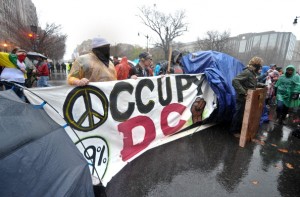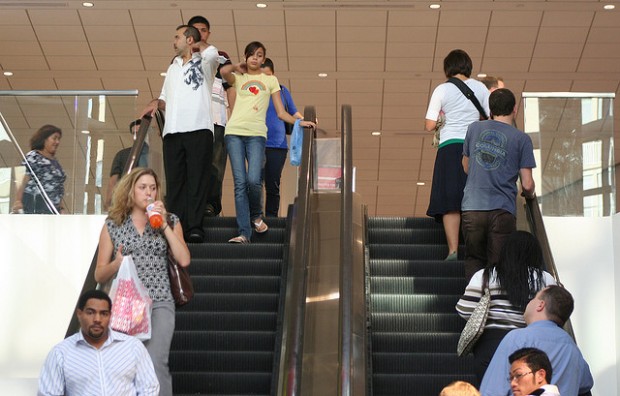Last year was sort of monumental for D.C., which led states in population growth for the first time in more than 70 years. The Atlantic senior editor Megan McArdle discusses what could happen to D.C.’s housing prices — which rose in 2011 — and population size if the federal government shrinks.
Author Archives: Elahe Izadi
Race, Class and the District: Top Five Stories of 2011
As the year comes to a close, DCentric is looking back on the five big stories where race and class intersected. Do you think there’s something we missed? Let us know in the comments section:

Nicholas Kamm / Getty Images
Occupy DC protesters block the intersection of 14th and K streets, NW.
The Occupy Movement spreads around the world and takes root in D.C.
The Occupy Movement began in New York City and spread to other cities, including D.C. Protestors have focused much of their ire on the economic inequality that’s left the nation’s wealth in the hands of a very small minority. There has been a fair share of criticism of the movement, including some targeting its lack of representation of those who have been most hurt by the economic crisis: people of color. In recent weeks, protesters have decamped in numerous cities, but their presence remains in D.C.
D.C. no longer “Chocolate City.”
This was a landmark year for the District when it comes to demographics. D.C.’s black population dipped below the 50 percent mark sometime in February, according to census estimates. This comes after more than four decades of the District being “Chocolate City,” a nickname reflecting its status as a majority-black city. D.C. also led states in population growth in 2011 for the first time in more than 70 years.
D.C. ‘Unhip’ Because It’s Too Expensive for Artists?
Is D.C. too expensive for artists, or is there still space for a thriving artist community, despite the increasingly pricey housing market? In a Slate piece Thursday, Matthew Yglesias writes that D.C. is woefully “unhip” because, unlike cities such as Philadelphia, it’s simply too expensive for the “semi-employed artist or guitar player” to live and create here.
Washington City Paper‘s Ryan Little, a self-proclaimed semi-employed guitarist, responds Friday. While conceding that D.C.’s rents may be expensive, Little writes that there are still cheap places to live. Also, he notes, D.C. offers a number of benefits that make the arts cheaper and more accessible than in other cities.
Why D.C. Isn’t ‘Hip’
D.C. isn’t hip, and our expensive housing market may be to blame. That’s according to Slate’s Matthew Yglesias, who writes the District attracts politicos and high-end services. “But by the same token,” he writes, “if you’re a semi-employed artist or guitar player [D.C.] is much more expensive than Philadelphia or Baltimore and still smaller and less interesting than New York City, which has less than one-third our murder rate.”
Some District artists are finding themselves priced out of living and working in D.C. Go-go, D.C.’s homegrown music genre, is increasingly being relegated to the suburbs. Nonprofit and government-subsidized housing and grants present one solution to keeping artists within the District’s borders, but it may not be enough to keep it cost-effective for all D.C. artists to remain.
Gentrification? Try Gentefication.

Leo Reynolds / Flickr
Gentrification, the "G" word, can be a very loaded term.
We write plenty about gentrification here on DCentric, which can be a very loaded word. But what about “gentefication?” According to our sister blog Multi-American, gentefication is “the process of upwardly mobile Latinos, typically second-generation and beyond, investing in and returning to the old neighborhood.” The “gente” comes from the Spanish word for “people.”
Gentefication is being used to describe what’s happening in L.A.’s Boyle Heights neighborhood, where Latino investors are developing low-income areas, with businesses attracting second-generation and English-speaking crowds. Some low-income locals of Mexican descent are worried they’ll be displaced by all of this development, even if the business owners are Latino, too.
In D.C., gentrification has taken hold in working class black and Latino neighborhoods, and most of D.C.’s well-to-do newcomers are white; in a city that’s mostly black, 60 percent of households making more than $75,000 are white, according to census data. Therefore the word “gentrification” in D.C. tends to imply neighborhood changes have to do with class and race.
But gentrification, even in the District, isn’t always about race. Take Anacostia, where the gentrification that’s starting to occur is class-based; professional African Americans are settling in the predominately black, low-income area. And just as in L.A.’s Boyle Heights, some of these newcomers have roots in the city and are returning to the places they grew up. So is gentrification the best way to describe what’s happening in Anacostia, or do we need a new word, too?
D.C.-Area Black Students Suspended More than White Students
African American students are suspended at much higher rates than their white peers throughout the D.C.-metro area, according to a Washington Post analysis. Why the difference? Although poverty may play a role, there may be some unintended bias against black students. Also, black students may be attending schools with more punitive leadership styles.
Such disparities in school discipline have come under the microscope by the U.S. Justice and Education departments. This summer, they launched an initiative to address the “school-to-prison pipeline,” a set of school policies that can lead to students dropping out and ending up in the criminal justice system.
Combating Stereotypes Using Comedy
Comedy can be one of the most disarming ways to combat stereotypes. Four Muslim-American comics of Middle Eastern descent are touring the deep south on a mission: to use their using their jokes to dispel myths about Islam and to paint a broader, more accurate picture of Muslims and Middle Easterners who also identify as American.
How D.C. Changed in 2011

Elvert Barnes / Flickr
A diverse group of people ride up and down escalators at DC USA in Columbia Heights. D.C. experienced dramatic demographic changes in 2011.
The year is nearly coming to a close, so we thought we’d take a look back to see just how much D.C. changed in 2011. Here’s our list, and feel free to contribute more in the comments section:
Wealth Gap Widens Between Congressmen and Constituents
Since the 1980s, the median net worth of the average congressman has doubled, a Washington Post study found. At the same time, the net worth of the average family has declined. The result: a widening gulf in wealth between lawmakers and the public.
There may be a number of reasons behind the growing gap. For one, the overall income gap between the poor and rich has grown. Also, political campaigns have become increasingly expensive endeavors, meaning the rich are more likely to run for office and win.
D.C. One of Two Cities Where Housing Prices Increased in 2011
Rising home values contribute to gentrification, and D.C. remains one of the only cities on the S&P/Case-Shiller index where housing prices increased in 2011, according to data released Tuesday. The other city is Detroit, where the recession caused steep declines in home values that are now beginning to rise again.
Home prices dropped by 3.4 percent nationally, while they increased by 1.3 percent in D.C.








